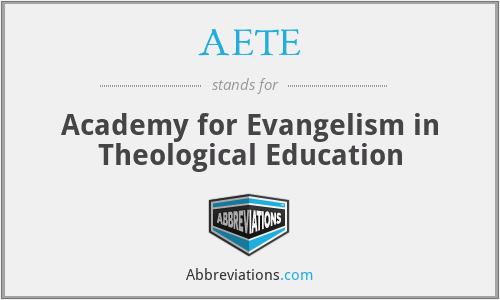What does AETE mean in Educational?
This page is about the meanings of the acronym/abbreviation/shorthand AETE in the Community field in general and in the Educational terminology in particular.
Academy for Evangelism in Theological Education
Submitted by S4Bot on April 11, 2016
Translation
Find a translation for Academy for Evangelism in Theological Education in other languages:
Select another language:
- - Select -
- 简体中文 (Chinese - Simplified)
- 繁體中文 (Chinese - Traditional)
- Español (Spanish)
- Esperanto (Esperanto)
- 日本語 (Japanese)
- Português (Portuguese)
- Deutsch (German)
- العربية (Arabic)
- Français (French)
- Русский (Russian)
- ಕನ್ನಡ (Kannada)
- 한국어 (Korean)
- עברית (Hebrew)
- Gaeilge (Irish)
- Українська (Ukrainian)
- اردو (Urdu)
- Magyar (Hungarian)
- मानक हिन्दी (Hindi)
- Indonesia (Indonesian)
- Italiano (Italian)
- தமிழ் (Tamil)
- Türkçe (Turkish)
- తెలుగు (Telugu)
- ภาษาไทย (Thai)
- Tiếng Việt (Vietnamese)
- Čeština (Czech)
- Polski (Polish)
- Bahasa Indonesia (Indonesian)
- Românește (Romanian)
- Nederlands (Dutch)
- Ελληνικά (Greek)
- Latinum (Latin)
- Svenska (Swedish)
- Dansk (Danish)
- Suomi (Finnish)
- فارسی (Persian)
- ייִדיש (Yiddish)
- հայերեն (Armenian)
- Norsk (Norwegian)
- English (English)
Definition
What does AETE mean?
- aete
- Apple events are the message-based interprocess communication mechanism in Mac OS, first making an appearance in System 7 and supported by every version of the classic Mac OS since then and by macOS. Apple events describe "high-level" events such as "open document" or "print file", whereas earlier OSs had supported much more basic events, namely "click" and "keypress". Apple events form the basis of the Mac OS scripting system, the Open Scripting Architecture (the primary language of such being AppleScript). The starting point is a dynamically-typed, extensible descriptor format called an AEDesc, which is just an OSType code specifying the data type, together with a block of type-dependent data. For instance, the OSType code inte indicates that the data was a four-byte signed integer in big-endian format. Besides predefined type codes for various common simple types, there are two predefined structured descriptor types: an AERecord, which has data type reco (record), and AEList with type list (list or array). The internal structure of these contain recursively-nested AEDescs, while the AERecord also associates each element with a unique record field ID, which is an OSType. The Apple Event Manager provides API calls to construct these structures, as well as extract their contents and query the type of contents they hold. The Apple Event Manager also supports coercions, which converts AEDescs from one data type to another. In addition to standard coercions, for instance between integer and real types, applications can install their own coercion handler callbacks, which handle conversions to and from custom data types. An Apple event proper is an AERecord with fields that depended on the purpose of the event. In addition, it has attributes (which are distinct from record fields, which are now called the parameters of the event) from a set predefined by the Apple Event Manager. These specify what the event is supposed to do (through event class and event ID), the target address to which the event is to be sent (which could be a process on the local or a remote machine), and various other options for handling it. Remote machines initially had to be connected via AppleTalk, but Mac OS 9 added the option for connections via TCP/IP. After sending an Apple event to its target process, the sending process can elect to receive a reply to an Apple event. This can contain various bits of information returned from the target about the processing of the original event, including an error code indicating success/failure, any information requested by the original event, and/or other appropriate information. Apple events are the foundation of the AppleEvent Object Model, which in turn is the foundation of the OSA and AppleScript. As of 2016, the official implementation of the Apple Event Manager API is available in C and its descendants, including C++. Official bindings are also provided for Objective-C and Swift through the Cocoa API. Unofficial bindings also exist for other languages (with varying degrees of limitation), including Perl, UserTalk, Ruby and Python.
Embed
Citation
Use the citation below to add this abbreviation to your bibliography:
Style:MLAChicagoAPA
"AETE." Abbreviations.com. STANDS4 LLC, 2024. Web. 6 May 2024. <https://www.abbreviations.com/term/1780147>.



Discuss this AETE abbreviation with the community:
Report Comment
We're doing our best to make sure our content is useful, accurate and safe.
If by any chance you spot an inappropriate comment while navigating through our website please use this form to let us know, and we'll take care of it shortly.
Attachment
You need to be logged in to favorite.
Log In